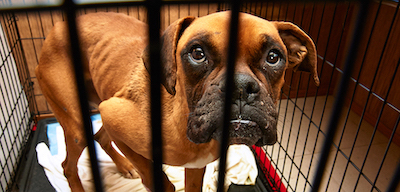Dogs possess an innate capacity to convey emotions through their behavior. Our faithful companions often reflect the lives we lead, but what happens when a dog manifests signs of distress or fear despite being in a loving and nurturing environment? This perplexing scenario raises essential questions about canine behavior, emotional health, and the remnants of past traumas that may linger in their psyche.
The inner world of a dog can be likened to a profound ocean, with depths that remain hidden from our understanding. Just as the ocean’s surface may appear calm while tumultuous currents swirl below, a dog’s outward demeanor can mask undercurrents of fear—a manifestation of imprinted experiences that predate their time with us.
When a dog exhibits signs of being abused—flinching from touch, cowering in corners, or displaying anxiety at sudden movements—an immediate instinct may be to question their past. It is crucial to remember that trauma can leave residual effects that persist long after the initial event. Even if your dog has never faced direct harm in your care, the echoes of previous encounters may reverberate through their behavior.
One poignant aspect to consider is the physical closeness that dogs share with humans. Their bodies translate our emotions, and if they were previously subjected to harsh environments, they might exhibit distress responses even in benign circumstances. The smallest of gestures, such as reaching out a hand or raising one’s voice, can evoke a historical memory of fear.
Pavlovian conditioning elucidates the methods by which animals learn associations. If a dog has previously experienced trauma, it may inherently link human actions with discomfort or danger. For example, a raised hand, once associated with a punishment, might trigger a cascade of anxiety in a dog, causing it to recoil instinctively. Understanding this phenomenon enables us to approach our pets with sensitivity and compassion, fostering a safe space for healing and trust.
There are numerous factors contributing to this bewildering behavior. Genetics play a significant role in shaping a dog’s temperament, as certain breeds may be predisposed to sensitivity or anxiety. This inclination can be accentuated by environmental factors such as inadequate socialization during formative stages, resulting in a heightened response to stimuli in the world around them.
Just as some individuals are more resilient to stress, others are more susceptible to emotional upheaval. This variability is observed across breed types and individual personalities. A timid dog may interpret the world through a lens of apprehension, influencing how it interacts with its surroundings. Hence, the perception of abuse may not solely stem from direct experiences but can also emerge from innate characteristics and learned behaviors.
Furthermore, physical health is a critical aspect of behavioral manifestations. A dog experiencing pain from an undiagnosed injury or chronic condition may display a shift in temperament that resembles the signs of past abuse. Discomfort can lead to irritability and fearfulness. It is essential to approach unusual behavioral patterns holistically, acknowledging the multifaceted influences that contribute to them, including potential medical issues.
Creating a nurturing environment is paramount for fostering emotional recovery. Engaging a dog through positive reinforcement, building trust, and establishing a routine can significantly alter their perception of safety. Patience is crucial; just as one cannot hurry the tides of the ocean, one must respect the necessary time it takes for a traumatized dog to acclimate to a loving household. Gentle encouragement, paired with consistent routines, allows the dog to anchor itself and establish pathways toward emotional stability.
Moreover, the importance of professional help cannot be understated. Animal behaviorists and trainers specializing in fear-related issues are equipped with strategies tailored to address the unique circumstances of each dog. Techniques such as desensitization and counter-conditioning can effectively reshape their associations with previously anxiety-inducing stimuli.
In the midst of caring for a dog that displays signs of traumatization, it is vital for pet owners to reflect upon their own emotions and intentions. Dogs have an extraordinary ability to perceive the emotional states of humans. A tense or anxious owner can create an atmosphere of unease, further solidifying the cycles of fear. Conversely, cultivating an aura of calmness and assurance can promote a sense of security within the dog. Through this emotional symbiosis, the healing journey can take root.
Ultimately, the journey to understanding why a dog acts as if it has endured abuse is one intertwined with empathy, knowledge, and patience. The intricate tapestry of canine behavior serves as a reminder that even within the context of unconditional love, remnants of the past can cast long shadows. As guardians of these sentient beings, it is our responsibility to illuminate those shadows, creating a sanctuary where they can flourish and thrive.
In conclusion, when faced with the unsettling reality of a dog exhibiting signs resembling abuse, it invites us to delve deeper into the complex world of animal emotions. By unraveling the threads of fear and anxiety, we can not only facilitate healing but also cultivate a relationship based on trust, understanding, and mutual affection. Embracing our role in their lives is the first step in transforming a once-troubled spirit into a vibrant and unconditionally devoted companion.










